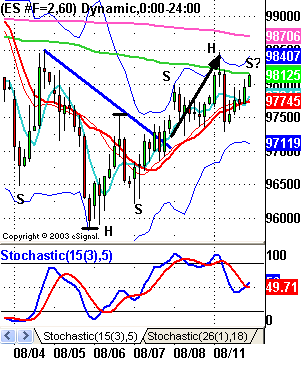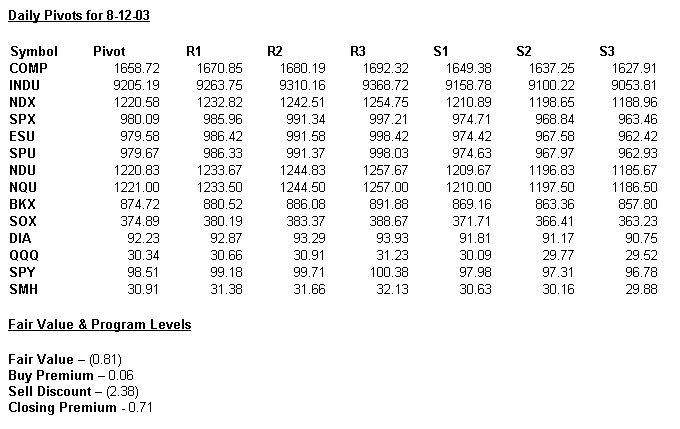Strong Hands vs. Weak Hands — What It Means To You
The September S&P
futures (SPU and ESU) opened Monday’s session with a small 1-point
gap to the downside. Volume was fairly light off the open, which eventually
became the theme for the entire session. The TRIN took a bullish slide below
1.0, where it stayed for the first hour. It looked like an uptrend day in the
making before the buyers simply dried up and the contract bled into negative
territory, where the futures found support at S1 in the 973 area and just above
Friday’s session low. The contract spent the rest of the session meandering in
and out of positive ground.
The September S&P 500 futures closed Monday’s
session with a gain of +3.25 points, and finished almost in the top 1/3 of its
range. Volume in the September ES was estimated at 478,000 contracts, which was
just ahead of Friday’s pace but still below average. On a daily basis, the
contract stalled at its 20-day MA at 984, and open interest continues to wane in
the face of the move up, which is telling us the move up really doesn’t have a
lot of momentum behind it.
The 60-min inverted head and shoulders pattern
that I posted on Friday hit its target before price rolled over and retraced to
possibly form the right shoulder of a regular head-and-shoulders pattern.

Tuesday’s session will be highlighted by (and
probably comatose until) the FOMC announcement at 2:15 pm ET. Mr. Greenspan and
Co. are expected to leave interest rates alone and the meeting will probably be
a non-event. The FOMC is walking a fine line here and will also likely be very
careful to avoid using the “D” word in its bias statement, after the last
meeting sent the market reeling. It will be interesting to see if any
optimistic statement on the U.S. economy can halt the recent rash of “sell the
good news” scenarios, but a little too much optimism would likely pressure an
already skittish bond market.
Contrary Opinion
The futures market is a “zero-sum” game in the
sense that, for each contract outstanding, there is 1 long position and 1 short
position. So, there is invariably 1 losing contract for every winning
contract. Due to this mandatory balance between buying and selling, contrary
opinion plays an even greater role in future price direction than in the stock
market.
Let’s say we do a survey of market participants
and find that 80% are bullish. How can 80% be bullish when each contract has a
winner and a loser? Very simple! In this case, there are many bulls each
holding, on the average, a relatively small number of contracts, as opposed to a
very few bears who are holding a relatively large number.
The minority in the market, the 20% who are
bearish in this case, will most likely be well financed because they hold a
large number of contracts. On the other hand, their opposition is probably
lightly financed. So, the short positions are said to be in the “strong hands”
while the longs are in the “weak hands” whose decisions are probably more
influenced by day-to-day price fluctuations.

Please feel free to email me with any questions
you might have, and good luck with your trading on Tuesday!
P.S. Learn to trade the E-minis in my new
interactive CD-ROM training module! Click
here for details.
